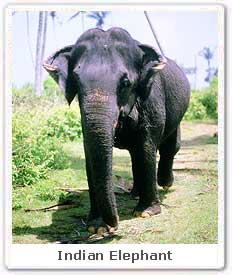| Kingdom : | Animalia |
| Phylum : | Chordata |
| Class: | Mammalia |
| Order : | Proboscidea |
| Family : | Elephantidae |
| Genus : | Elephas |
| Species: | E. maximus |
| Zoological name : | Elephas maximus |
| Found In : | Manas, Cobett and Periyar National Park in India |
 Physical appearance : The average height of the Indian
Elephant is estimated to be about 7 to 12 feet and weighs anything between
3,600 kg to 5000 kg. The length of their head and body is around 550 to 640
cm and shoulder height is 250 to300 cm. They have thick and dry skin. The
colour of their skin varies from grey to brown. They have smaller ears which
are straight at the bottom, an arched back and a single finger like
proturbance that is located at the tip of the trunk. Their brain weigh
around 5kg.They have unique modified incisor teeth known as tusks. Their
heart beat 28 times a minute. They are considered as the endangered species.
Physical appearance : The average height of the Indian
Elephant is estimated to be about 7 to 12 feet and weighs anything between
3,600 kg to 5000 kg. The length of their head and body is around 550 to 640
cm and shoulder height is 250 to300 cm. They have thick and dry skin. The
colour of their skin varies from grey to brown. They have smaller ears which
are straight at the bottom, an arched back and a single finger like
proturbance that is located at the tip of the trunk. Their brain weigh
around 5kg.They have unique modified incisor teeth known as tusks. Their
heart beat 28 times a minute. They are considered as the endangered species.Presence in India : The Indian Elephants are found in the wild in the dense forested areas of India including tropical forests of South India, North East India and the Sub Himalayan Region. Manas, Corbett, Dalma and Palamu, Bandipur and Nagarhole, Periyar and Madumalai are the best places to watch the Asian Elephants in its natural habitat.
Habitat : Indian Elephants live in different habitat in open grassland, marshes and savannas. They can also be found in jungles, water sources and mountainous regions.
Diet : The Indian Elephants mostly feeds on a wide variety of grasses. They are also dependent upon cultivated crops, bark, root, twigs, fruits and leaves. They are one among the herbivorous animals. An adult elephant can consume up to 300 pounds of food in a single day.
Reproduction :There is no specific mating season for the Indian Elephants. Both males ans females become sexually mature at about 14 years of age. The gestation period is usually 20- 22 months and the females have the capability of giving birth to a calf in every four to five years. At birth elephants can be one meter tall and weigh around ninety kilograms. They can stand soon after the birth. Female elephants supervise their young ones for several years after weaning.
Conservation status : The population of the Indian Elephants lies somewhere between 38,000 and 51,000. They have been continuously haunted by the people for the food, for ivory and for the domestic stock. They have suffered the great habitat loss due to the deforestation and agriculture.
Lifespan : Lifespan of the Indian Elephants is about 70 years.






